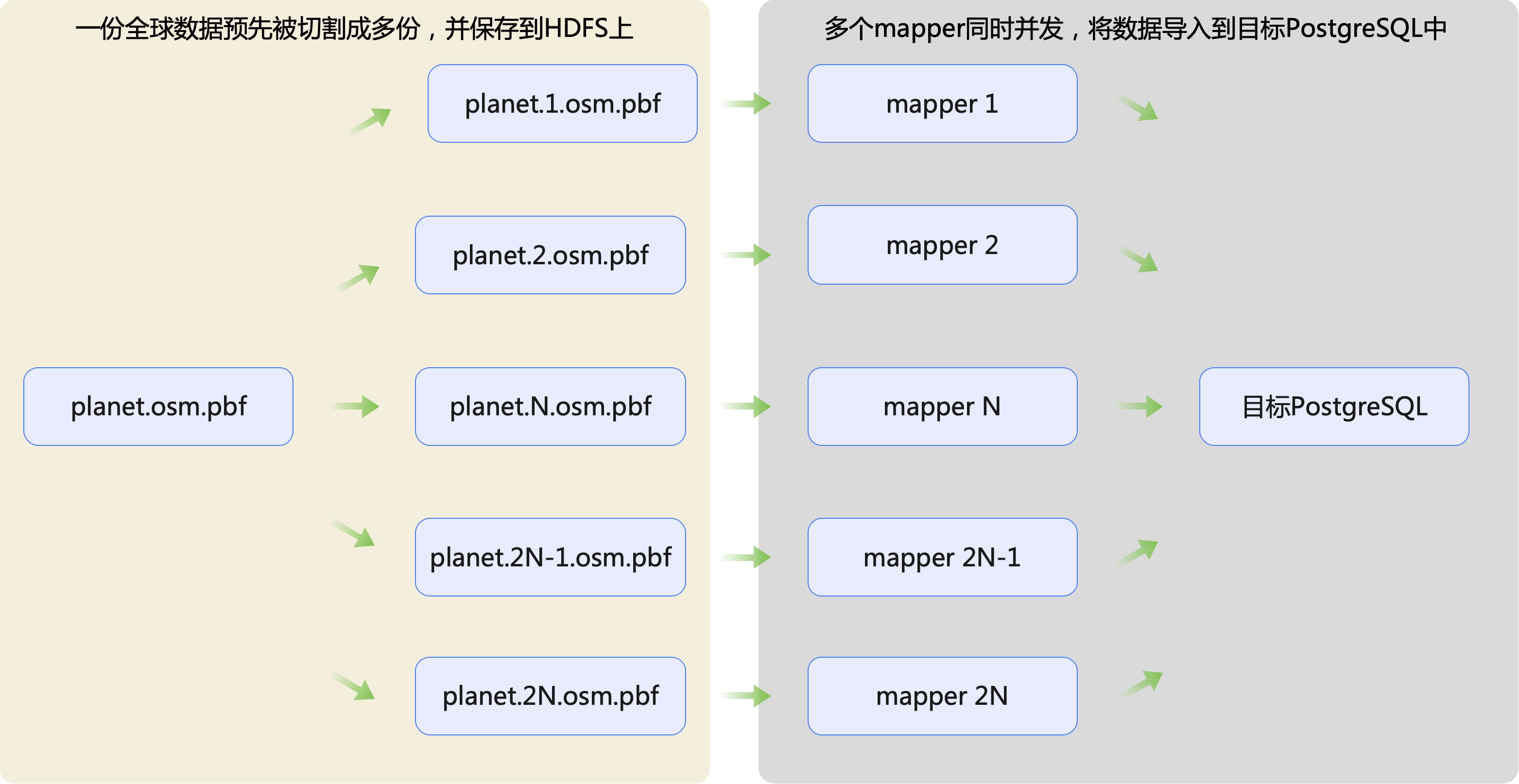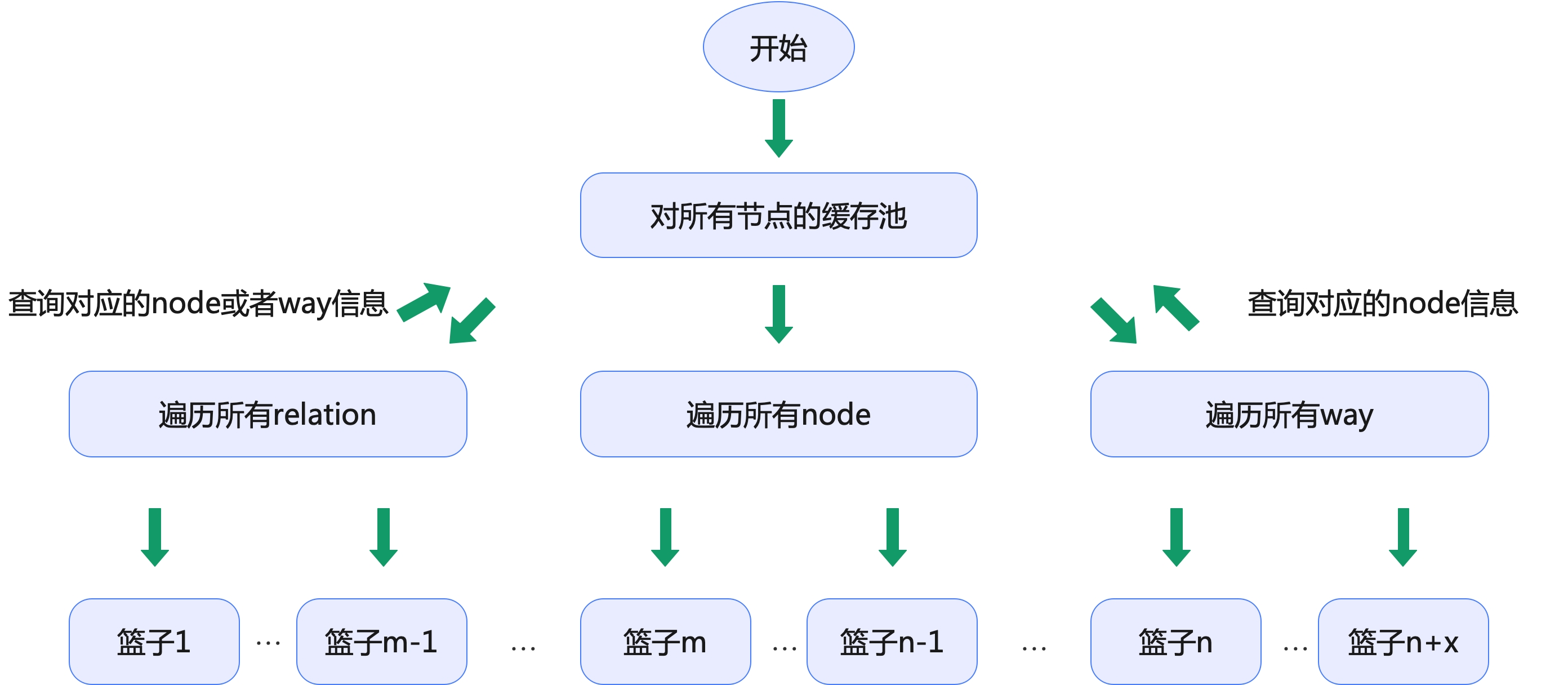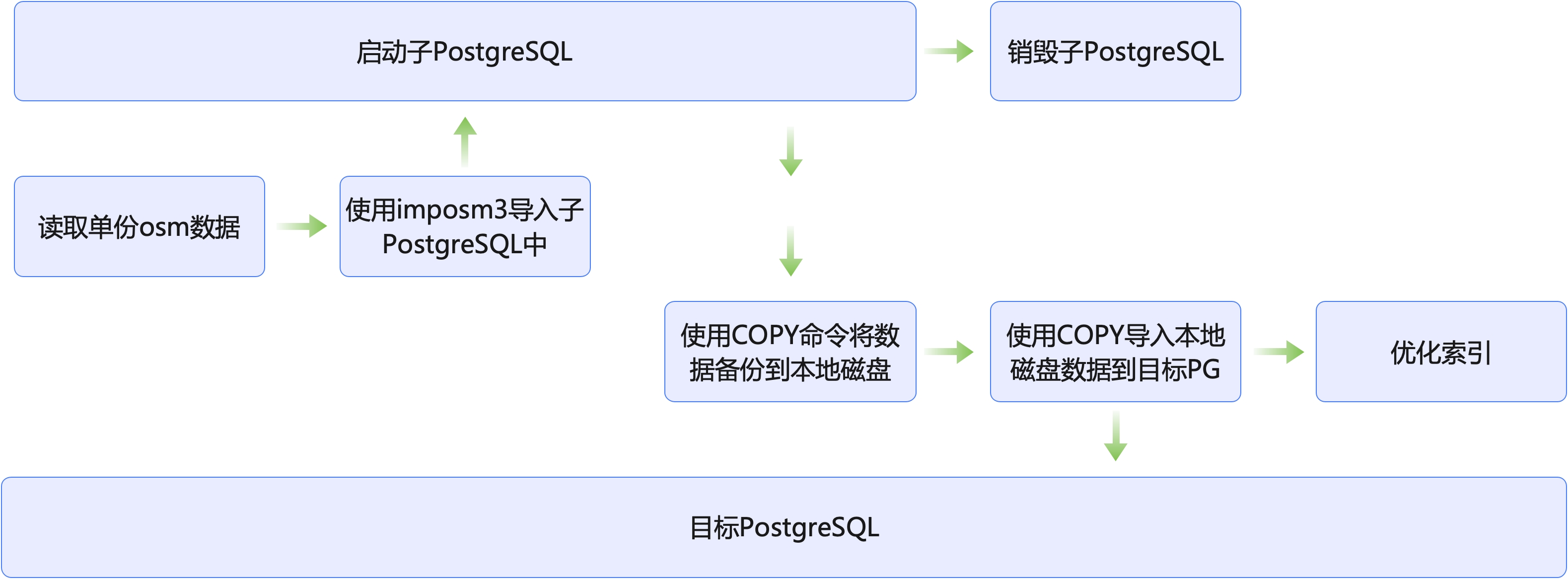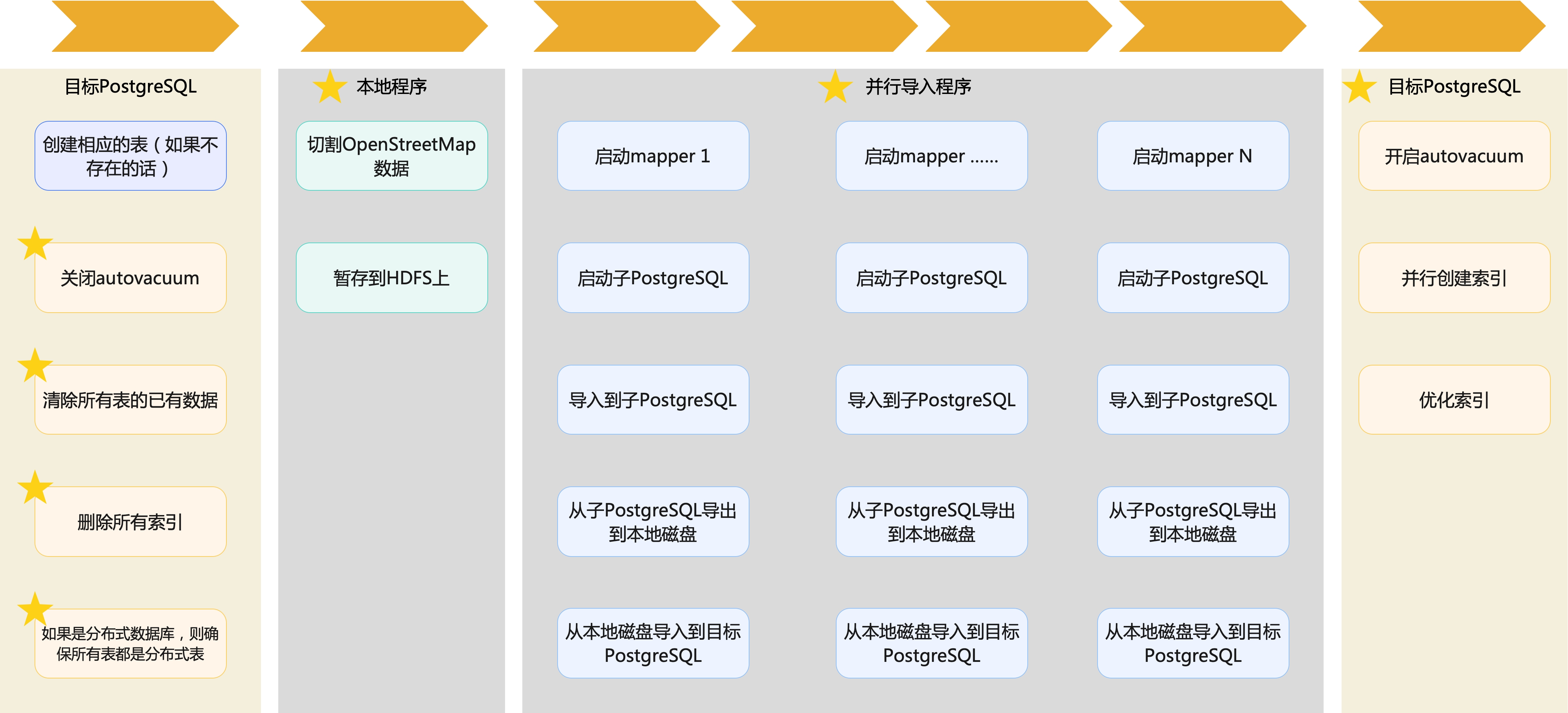基于Hadoop和imposm3来加速OpenStreetMap数据的导入
基于Hadoop和imposm3来加速OpenStreetMap数据的导入
一、需求
在基于OpenStreetMap的离线地图建设方案中,osm数据文件需要导入到PostgreSQL中。官方也提供了一些工具来实现这一过程,比如性能相对比较好的 omniscale/imposm3。但问题还是在于OpenStreetMap的全球数据实在忒大,即使采用imposm3也需要数天时间。
于是,我们就需要一种更高效快捷的方式。
二、技术实现方案
2.1 默认imposm3的流程
我们先看一下imposm3的默认流程:

在这个流程中,写入数据的过程其实同时会创建索引。而优化索引是执行了PostgreSQL的CLUSTER和ANALYZE两个语句:

众所周知,创建索引的过程本身就挺慢的,此外,更不幸的是,CLUSTER还会锁表。并且就我的观察而言,数据导入后,大量的时间都花在了CLUSTER这个阶段。虽然,imposm3中的CLUSTER是可选的,可以不传入-optimize参数。但OpenStreetMap的全球数据终究太大了,还是希望能对数据库索引做一些优化的,以达到最佳的性能。 此外,因为imposm3本身是单机版的,在加载&解析OSM数据,并且将解析后的数据导入到PostgreSQL相应表中也是相当地缓慢。
2.2 整体的优化思路
我从以下几个阶段来入手:

2.3 并行写入OSM数据

基于上图,这里有以下几个技术点:
- 一份全球planet.osm.pbf如何快速地被切换成多份?
- mapper阶段又如何快速将数据导入到目标PostgreSQL中?
2.3.1 一份全球planet.osm.pbf如何快速地被切换成多份?
2.3.1.1 切割原则
我们按照什么切割原则来将planet.osm.pbf数据切成多份,有两种方法:
- 方法一:一个最合理的方案其实是按照国境线(如果一个国家面积太大,比如我国、俄罗斯、漂亮国之类的,就按省、州、联邦等二级粒度来切)。
- 方法二:将经纬度按照一定步长来切
这两种方法都可以,并且我都尝试过。
2.3.1.2 按照国境线来切
比较所幸的是:download.geofabrik.de 已经提供了类似类似我上面提到的,把世界切成多个国家、甚至这些面积大的国家按二级粒度来切,我们只要写一个爬虫把这些.osm.pbf抓取下来就行:
#!/usr/bin/env node
const _ = require("lodash");
const cheerio = require('cheerio');
const axios = require("axios");
const {URL} = require('url');
const fs = require("fs");
const path = require("path");
const crypto = require('crypto');
const winston = require('winston');
const {SingleBar} = require('cli-progress');
const PROXY_PREFIX = ""
const INDEX_PAGE = "https://download.geofabrik.de/";
const logger = winston.createLogger({
// 定义日志级别
level: 'info',
// 定义日志的格式
format: winston.format.printf(info => `${info.timestamp} ${info.level}: ${info.message}`),
// 定义日志的输出
transports: [
// 控制台输出
new winston.transports.Console({
format: winston.format.combine(
winston.format.timestamp({
format: 'YYYY-MM-DD HH:mm:ss'
}),
winston.format.colorize(),
winston.format.printf(info => `${info.timestamp} ${info.level}: ${info.message}`)
)
})
]
});
async function getPage(url) {
while (true) {
try {
let response = await axios.get(`${PROXY_PREFIX}/${url}`, {
rejectUnauthorized: false,
userAgent: 'Mozilla/5.0 (Macintosh; Intel Mac OS X 10_15_7) AppleWebKit/537.36 (KHTML, like Gecko) Chrome/129.0.0.0 Safari/537.36'
});
if (response.status !== 200) {
continue;
}
return response.data;
} catch (e) {
}
}
}
/**
* 是否有子区域
*/
async function hasSubRegions(url) {
if (url === INDEX_PAGE) {
return true;
}
const html = await getPage(url);
const $ = cheerio.load(html);
return $("#subregions").length > 1;
}
async function getFinalDownloadUrl(currentUrl) {
let osmUrl = {
url: "",
md5sum: ""
}
const $ = cheerio.load(await getPage(currentUrl));
$(".download-main a").each((index, element) => {
if (osmUrl.url.length > 0) {
return;
}
let $element = $(element);
let href = $element.attr("href");
if (href.endsWith(".osm.pbf")) {
const fullUrl = new URL(href, currentUrl);
osmUrl.url = fullUrl.href;
}
});
$(".download-main a").each((index, element) => {
if (osmUrl.md5sum.length > 0) {
return;
}
let $element = $(element);
let href = $element.attr("href");
if (href.endsWith(".osm.pbf.md5")) {
osmUrl.md5sum = $element.text();
}
});
return osmUrl;
}
async function getDownloadUrls(url) {
let results = [];
const isLastPage = !await hasSubRegions(url);
if (isLastPage) {
const finalDownloadUrl = await getFinalDownloadUrl(url);
logger.info(`${url} is last page, osm.pbf: ${finalDownloadUrl.url}`);
results.push(finalDownloadUrl);
return results;
}
const html = await getPage(url);
const $ = cheerio.load(html);
for (const element of $("#subregions:last .subregion a")) {
const href = $(element).attr("href");
const fullUrl = new URL(href, url);
logger.info(`${url} is index page, goto ${fullUrl.href}`);
for (const r of await getDownloadUrls(fullUrl.href)) {
results.push(r);
}
}
return results;
}
async function downloadFile(url, outputPath) {
// 创建一个新的进度条实例
const progressBar = new SingleBar({
format: '下载进度 |{bar}| {percentage}% || {value}/{total} Chunks',
barCompleteChar: '\u2588',
barIncompleteChar: '\u2591',
hideCursor: true
});
try {
// 发起GET请求
const response = await axios({
method: 'get',
url: `${PROXY_PREFIX}/${url}`,
responseType: 'stream',
rejectUnauthorized: false,
userAgent: 'Mozilla/5.0 (Macintosh; Intel Mac OS X 10_15_7) AppleWebKit/537.36 (KHTML, like Gecko) Chrome/129.0.0.0 Safari/537.36'
});
// 准备写入文件流
const writer = fs.createWriteStream(outputPath);
// 获取内容长度
const totalLength = response.headers['content-length'];
// 初始化进度条
progressBar.start(totalLength, 0);
let receivedLength = 0;
// 监听数据事件
response.data.on('data', (chunk) => {
receivedLength += chunk.length;
progressBar.update(receivedLength);
});
// 数据写入文件
response.data.pipe(writer);
return new Promise((resolve, reject) => {
writer.on('finish', () => {
progressBar.stop();
resolve(true);
});
writer.on('error', (err) => {
progressBar.stop();
reject(false);
});
// 处理响应错误
response.data.on('error', (err) => {
progressBar.stop();
writer.close();
reject(false);
});
});
} catch (error) {
progressBar.stop();
// 关闭并删除未完成的文件
if (fs.existsSync(outputPath)) {
fs.unlinkSync(outputPath);
}
return false;
}
}
async function getMD5SUM(filename) {
return new Promise((resolve, reject) => {
const stream = fs.createReadStream(filename);
const hash = crypto.createHash('md5');
stream.on('data', chunk => {
hash.update(chunk, 'utf8');
});
stream.on('end', () => {
const md5 = hash.digest('hex');
resolve(md5);
});
stream.on('error', reject);
});
}
async function main() {
const outputDir = fs.realpathSync(process.argv[2]);
if (!fs.existsSync(outputDir)) {
fs.mkdirSync(outputDir, {recursive: true, mode: 0o755});
}
const downloads = await getDownloadUrls(INDEX_PAGE);
for (const osm of downloads) {
logger.info(`Downloading ${osm.url}`);
const targetFilename = _.join(_.split(_.replace(_.replace(new URL(osm.url).pathname, /^\//, ""), "-latest", ""), "/"), "-");
const targetFile = path.join(outputDir, targetFilename);
while (true) {
try {
const success = await downloadFile(osm.url, targetFile);
if (!success) {
continue;
}
const calValue = await getMD5SUM(targetFile);
if (calValue !== osm.md5sum) {
logger.error(`${targetFile} md5sum mismatch, expected: ${osm.md5sum}, actual: ${calValue}`);
continue;
}
} catch (e) {}
break;
}
}
}
main().then(async () => {
logger.info("下载完成");
}).catch((e) => {
logger.error(`下载失败: ${e}`);
})
另外,如果就是想自己切的话,geoboundaries也提供了三级粒度的GeoHash值,直接拿来用就可以了。
#include <iostream>
#include <argparse/argparse.hpp>
#include <filesystem>
#include <fstream>
#include <utility>
#include <chrono>
#include <osmium/io/any_input.hpp>
#include <osmium/io/any_output.hpp>
#include <osmium/io/reader_with_progress_bar.hpp>
#include <osmium/io/writer.hpp>
#include <osmium/io/pbf_input.hpp>
#include <osmium/util/progress_bar.hpp>
#include <osmium/util/verbose_output.hpp>
#include <osmium/util/file.hpp>
#include <osmium/index/map/all.hpp>
#include <osmium/handler/node_locations_for_ways.hpp>
#include <osmium/geom/haversine.hpp>
#include <osmium/area/assembler.hpp>
#include <osmium/area/multipolygon_manager.hpp>
#include <osmium/area/assembler.hpp>
#include <osmium/area/multipolygon_collector.hpp>
#include <osmium/builder/osm_object_builder.hpp>
#include <osmium/handler/node_locations_for_ways.hpp>
#include <osmium/index/map/sparse_mem_array.hpp>
#include <osmium/io/any_input.hpp>
#include <osmium/io/file.hpp>
#include <osmium/memory/buffer.hpp>
#include <osmium/index/map/dense_file_array.hpp>
#include <nlohmann/json.hpp>
#include <osmium/geom/coordinates.hpp>
#include <osmium/visitor.hpp>
#include <spdlog/spdlog.h>
#include <cstdlib>
#include <random>
#include <fmt/core.h>
#include <thread>
#include <mutex>
#include <cmath>
#include <boost/geometry.hpp>
#include <boost/geometry/geometries/point.hpp>
#include <boost/geometry/geometries/polygon.hpp>
#include <boost/algorithm/string.hpp>
using json = nlohmann::json;
using index_type = osmium::index::map::SparseFileArray<osmium::unsigned_object_id_type, osmium::Location>;
using location_handler_type = osmium::handler::NodeLocationsForWays<index_type>;
namespace bg = boost::geometry;
typedef bg::model::point<double, 2, bg::cs::cartesian> Point;
typedef bg::model::polygon<Point> Polygon;
enum ADMLevel {
ADM0 = 0,
ADM1,
ADM2,
ADM99,
};
class IGeoJSONFeature {
public:
virtual bool contains(double x, double y) = 0;
virtual std::string get_shape_name() = 0;
virtual ADMLevel get_adm_level() = 0;
public:
virtual ~IGeoJSONFeature() {};
};
class InnerGeoJSONFeature : public IGeoJSONFeature {
public:
ADMLevel admLevel;
std::string shapeName;
std::vector<Polygon *> coordinates;
public:
virtual ~InnerGeoJSONFeature() {};
public:
bool contains(double x, double y) override {
Point p(x, y);
bool inside = false;
for (Polygon *iter: coordinates) {
if (bg::within(p, *iter)) {
inside = true;
break;
}
}
return inside;
}
std::string get_shape_name() override {
return shapeName;
}
ADMLevel get_adm_level() override {
return admLevel;
}
};
class OuterGeoJSONFeature : public IGeoJSONFeature {
public:
ADMLevel admLevel{ADM99};
std::string shapeName{"others"};
std::vector<Polygon *> coordinates;
public:
virtual ~OuterGeoJSONFeature() {}
public:
bool contains(double x, double y) override {
Point p(x, y);
bool inside = false;
for (Polygon *iter: coordinates) {
if (bg::within(p, *iter)) {
inside = true;
break;
}
}
return !inside;
}
std::string get_shape_name() override {
return shapeName;
}
ADMLevel get_adm_level() override {
return admLevel;
}
};
void parse_geojson(const std::string &geojson_path, ADMLevel admLevel, std::vector<IGeoJSONFeature *> *geoJsonFeatures) {
std::ifstream geojson_file(geojson_path);
json geojson;
geojson_file >> geojson;
for (auto &feature: geojson["features"]) {
InnerGeoJSONFeature *geoJsonFeature = new InnerGeoJSONFeature();
geoJsonFeatures->push_back(geoJsonFeature);
geoJsonFeature->admLevel = admLevel;
geoJsonFeature->shapeName = feature["properties"]["shapeName"];
auto &geometry = feature["geometry"];
if (geometry["type"] == "Polygon") {
Polygon *polygon = new Polygon();
for (auto &level1: geometry["coordinates"]) {
for (auto &level2: level1) {
bg::append(polygon->outer(), Point(level2[0], level2[1]));
}
}
bg::correct(*polygon);
geoJsonFeature->coordinates.push_back(polygon);
} else if (geometry["type"] == "MultiPolygon") {
for (auto &level0: geometry["coordinates"]) {
Polygon *polygon = new Polygon();
for (auto &level1: level0) {
for (auto &level2: level1) {
bg::append(polygon->outer(), Point(level2[0], level2[1]));
}
}
bg::correct(*polygon);
geoJsonFeature->coordinates.push_back(polygon);
}
}
}
geojson_file.close();
}
std::string join_paths(const std::string &path1, const std::string &path2) {
if (path1.empty()) return path2;
if (path2.empty()) return path1;
std::filesystem::path p1(path1);
std::filesystem::path p2(path2);
return (p1 / p2).string();
}
class CacheLocationHandler : public osmium::handler::Handler {
private:
location_handler_type &location_handler;
public:
CacheLocationHandler(location_handler_type &loc_handler) : location_handler(loc_handler) {
}
void node(const osmium::Node &node) {
osmium::Location location = node.location();
if (!location.valid()) {
return;
}
location_handler.node(node);
}
void way(const osmium::Way &way) {
if (way.nodes().empty()) {
return;
}
location_handler.way(const_cast<osmium::Way &>(way));
}
void relation(const osmium::Relation &relation) {
if (relation.members().empty()) {
return;
}
location_handler.relation(relation);
}
};
class MultiWriterHandler : public osmium::handler::Handler {
private:
std::vector<IGeoJSONFeature *> primary_features;
std::vector<IGeoJSONFeature *> secondary_features;
std::vector<IGeoJSONFeature *> other_features;;
std::vector<osmium::io::Writer *> primary_writers;
std::vector<osmium::io::Writer *> secondary_writers;
std::vector<osmium::io::Writer *> other_writers;
location_handler_type &location_handler;
public:
MultiWriterHandler(
const std::int32_t thread_id,
const std::vector<std::string> &output_dirs,
const std::vector<IGeoJSONFeature *> *features,
location_handler_type &loc_handler
)
:
location_handler(loc_handler) {
for (const auto &feature: *features) {
if (feature->get_adm_level() == ADM0) {
primary_features.push_back(feature);
} else if (feature->get_adm_level() == ADM1) {
secondary_features.push_back(feature);
} else if (feature->get_adm_level() == ADM99) {
other_features.push_back(feature);
}
}
std::random_device rd; // 随机数设备
std::default_random_engine eng(rd()); // 随机数引擎
std::uniform_int_distribution<> distr(0, output_dirs.size() - 1);
for (const auto &feature: primary_features) {
std::string shape_name = feature->get_shape_name();
boost::replace_all(shape_name, " ", "-");
std::string pbf_filename = fmt::format("{}_{}.osm.pbf", shape_name, thread_id);
this->primary_writers.push_back(new osmium::io::Writer(join_paths(output_dirs[distr(eng)], pbf_filename), osmium::io::overwrite::allow));
}
for (const auto &feature: secondary_features) {
std::string shape_name = feature->get_shape_name();
boost::replace_all(shape_name, " ", "-");
std::string pbf_filename = fmt::format("{}_{}.osm.pbf", shape_name, thread_id);
this->secondary_writers.push_back(new osmium::io::Writer(join_paths(output_dirs[distr(eng)], pbf_filename), osmium::io::overwrite::allow));
}
for (const auto &feature: other_features) {
std::string pbf_filename = fmt::format("{}_{}.osm.pbf", feature->get_shape_name(), thread_id);
this->other_writers.push_back(new osmium::io::Writer(join_paths(output_dirs[distr(eng)], pbf_filename), osmium::io::overwrite::allow));
}
}
~MultiWriterHandler() {
for (auto &writer: primary_writers) {
writer->close();
delete writer;
}
for (auto &writer: secondary_writers) {
writer->close();
delete writer;
}
for (auto &writer: other_writers) {
writer->close();
delete writer;
}
}
bool pick_to_basket(const osmium::Location &location, const osmium::OSMObject &object) {
if (!location.valid()) {
return false;
}
double lon = location.lon();
double lat = location.lat();
for (std::size_t i = 0; i < secondary_features.size(); i++) {
IGeoJSONFeature *feature = secondary_features.at(i);
if (feature->contains(lon, lat)) {
(*secondary_writers[i])(object);
return true;
}
}
for (std::size_t i = 0; i < primary_features.size(); i++) {
IGeoJSONFeature *feature = primary_features.at(i);
if (feature->contains(lon, lat)) {
(*primary_writers[i])(object);
return true;
}
}
// for (std::size_t i = 0; i < other_features.size(); i++) {
// IGeoJSONFeature *feature = other_features.at(i);
// if (feature->contains(lon, lat)) {
// (*other_writers[i])(object);
// return true;
// }
// }
return false;
}
void node(const osmium::Node &node) {
osmium::Location location = node.location();
// auto start = std::chrono::system_clock::now();
pick_to_basket(location, node);
// auto end = std::chrono::system_clock::now();
// SPDLOG_INFO("pick node: {}, speed: {} ms", node.id(), std::chrono::duration_cast<std::chrono::milliseconds>(end - start).count());
}
void way(const osmium::Way &way) {
if (way.nodes().empty()) {
return;
}
// auto start = std::chrono::system_clock::now();
for (const auto &node_ref: way.nodes()) {
osmium::Location loc = location_handler.get_node_location(node_ref.ref());
bool picked = pick_to_basket(loc, way);
if (picked) {
break;
}
}
// auto end = std::chrono::system_clock::now();
// SPDLOG_INFO("pick way: {}, speed: {} ms", way.id(), std::chrono::duration_cast<std::chrono::milliseconds>(end - start).count());
}
void relation(const osmium::Relation &relation) {
if (relation.members().empty()) {
return;
}
// auto start = std::chrono::system_clock::now();
for (const auto &member: relation.members()) {
if (member.type() == osmium::item_type::node || member.type() == osmium::item_type::way) {
osmium::Location loc = location_handler.get_node_location(member.ref());
if (pick_to_basket(loc, relation)) {
break;
}
}
}
// auto end = std::chrono::system_clock::now();
// SPDLOG_INFO("pick relation: {}, speed: {} ms", relation.id(), std::chrono::duration_cast<std::chrono::milliseconds>(end - start).count());
}
};
void process_boxes_chunk(
const std::int32_t thread_id,
const std::vector<std::string> &output_dirs,
location_handler_type &location_handler,
const std::vector<IGeoJSONFeature *> &features_chunk,
const std::string &input_pbf,
std::mutex &output_mutex) {
osmium::io::File input_file(input_pbf);
osmium::io::Reader reader(input_file, osmium::osm_entity_bits::all);
osmium::io::Header header;
MultiWriterHandler handler(thread_id, output_dirs, &features_chunk, location_handler);
osmium::apply(reader, handler);
reader.close();
std::lock_guard<std::mutex> lock(output_mutex);
}
int main(int argc, char *argv[]) {
spdlog::set_level(spdlog::level::info);
spdlog::set_pattern("%+");
argparse::ArgumentParser program("按照bbox范围切割.osm.pbf文件");
program.add_argument("--input")
.required()
.help("输入 PBF 文件路径");
program.add_argument("--output-dir")
.required()
.nargs(argparse::nargs_pattern::at_least_one)
.help("输出文件的目录,支持多个目录");
program.add_argument("--geojson")
.required()
.nargs(argparse::nargs_pattern::at_least_one)
.help("GEOJSON文件");
program.add_argument("--threads-num").scan<'i', int>().default_value(20).help("线程数");
program.add_argument("--use-cache").default_value(false).implicit_value(true).help("是否使用缓存");
program.add_argument("--index-file").help("索引文件路径");
try {
program.parse_args(argc, argv);
} catch (const std::runtime_error &err) {
std::cerr << err.what() << std::endl;
std::cerr << program;
return EXIT_FAILURE;
}
std::string input_pbf = program.get<std::string>("--input");
std::vector<std::string> output_dirs = program.get<std::vector<std::string>>("--output-dir");
std::vector<std::string> geojson_files = program.get<std::vector<std::string>>("--geojson");
int threads_num = program.get<int>("--threads-num");
bool use_cache = program.get<bool>("--use-cache");
std::string index_path;
if (use_cache) {
index_path = program.get<std::string>("--index-file");
if (!std::filesystem::exists(index_path)) {
SPDLOG_ERROR("索引文件: {} 不存在", index_path);
return EXIT_FAILURE;
}
} else {
index_path = join_paths(output_dirs.at(0), "index.idx");
if (std::filesystem::exists(index_path)) {
std::remove(index_path.c_str());
}
}
if (!std::filesystem::exists(input_pbf)) {
SPDLOG_ERROR("输入文件: {} 不存在", input_pbf);
return EXIT_FAILURE;
}
for (auto &output_dir: output_dirs) {
if (!std::filesystem::exists(output_dir)) {
SPDLOG_INFO("输出目录: {} 不存在,自动创建……");
std::filesystem::create_directories(output_dir);
}
}
if (geojson_files.size() > 2) {
SPDLOG_ERROR("目前只支持到ADM1级别");
return EXIT_FAILURE;
}
std::vector<IGeoJSONFeature *> geojson_features;
std::int32_t i = 0;
for (i = 0; i < std::min((int)geojson_files.size(), 2); i++) {
ADMLevel admLevel;
if (i == 0) {
admLevel = ADMLevel::ADM0;
} else if (i == 1) {
admLevel = ADMLevel::ADM1;
} else {
admLevel = ADMLevel::ADM2;
}
parse_geojson(geojson_files.at(i), admLevel, &geojson_features);
}
OuterGeoJSONFeature *outerGeoJsonFeature = new OuterGeoJSONFeature();
for (IGeoJSONFeature* feature: geojson_features) {
InnerGeoJSONFeature* innerGeoJsonFeature = dynamic_cast<InnerGeoJSONFeature*>(feature);
std::copy(innerGeoJsonFeature->coordinates.begin(), innerGeoJsonFeature->coordinates.end(), std::back_inserter(outerGeoJsonFeature->coordinates));
}
geojson_features.push_back(outerGeoJsonFeature);
SPDLOG_INFO("GeoJSON已加载完成,总共: {}", geojson_features.size());
int fd;
if (use_cache) {
fd = ::open(index_path.c_str(), O_RDWR, 0666);
} else {
fd = ::open(index_path.c_str(), O_RDWR | O_CREAT | O_EXCL, 0666);
}
if (fd == -1) {
SPDLOG_ERROR("open {} failed", index_path);
return EXIT_FAILURE;
}
index_type index{fd};
location_handler_type location_handler{index};
location_handler.ignore_errors();
if (!use_cache) {
auto start = std::chrono::system_clock::now();
SPDLOG_INFO("开始缓存节点信息");
osmium::io::File input_file(input_pbf);
osmium::io::Reader reader(input_file, osmium::osm_entity_bits::all);
osmium::io::Header header;
CacheLocationHandler handler(location_handler);
osmium::apply(reader, handler);
reader.close();
auto end = std::chrono::system_clock::now();
// 计算耗时,单位为秒
std::chrono::duration<double> elapsed_seconds = end - start;
SPDLOG_INFO("节点信息已经缓存完成, 耗时: {} 秒", elapsed_seconds.count());
}
threads_num = std::min(threads_num, static_cast<int>(geojson_features.size()));
SPDLOG_INFO("will generate {} osm.pbf files, by {} threads", geojson_features.size(), threads_num);
std::vector<std::thread> threads;
std::mutex output_mutex; // 用于线程安全地输出日志
int chunk_size = static_cast<int>(geojson_features.size()) / threads_num; // 每个线程处理的box数量
for (i = 0; i < threads_num; ++i) {
std::int32_t start_index = i * chunk_size;
std::int32_t end_index = start_index + chunk_size;
if (i != (threads_num - 1)) {
SPDLOG_INFO("start_index: {}, end_index: {}, chunk_size: {}", start_index, end_index, chunk_size);
std::vector<IGeoJSONFeature *> boxes_chunk(geojson_features.begin() + start_index, geojson_features.begin() + end_index);
threads.emplace_back(process_boxes_chunk, i, std::ref(output_dirs), std::ref(location_handler), boxes_chunk, std::ref(input_pbf), std::ref(output_mutex));
} else {
SPDLOG_INFO("start_index: {}, to end", start_index);
std::vector<IGeoJSONFeature *> boxes_chunk(geojson_features.begin() + start_index, geojson_features.end());
threads.emplace_back(process_boxes_chunk, i, std::ref(output_dirs), std::ref(location_handler), boxes_chunk, std::ref(input_pbf), std::ref(output_mutex));
}
}
// 等待所有线程完成
for (auto &thread: threads) {
if (thread.joinable()) {
thread.join();
}
}
SPDLOG_INFO("all osm.pbf files generated, begin to clean cache and free memory");
i = 0;
for (auto feature: geojson_features) {
if (InnerGeoJSONFeature* innerGeoJsonFeature = dynamic_cast<InnerGeoJSONFeature*>(feature)) {
for (auto p: innerGeoJsonFeature->coordinates) {
delete p;
}
}
delete feature;
}
if (!use_cache && std::filesystem::exists(index_path)) {
std::remove(index_path.c_str());
}
close(fd);
SPDLOG_INFO("all splitted completed");
return EXIT_SUCCESS;
}
2.3.1.3 按照bbox来切
在github上有一款工具:osmcode/osmium-tool支持将OpenStreetMap数据(planet.osm.pbf)按经纬度范围(bbox)来提出该经纬度范围内的数据,但问题在于如果直接使用osmcode/osmium-tool的bbox来切割,我们将经度范围:-180~180,维度范围:-90~90,按一定步长(10或者20),这么笛卡尔积地组合以下,整个时间复杂度是:O(n^2)。就笔者实际测试来看,当步长是10的话,按此笛卡尔积地组合切割的话,需要一周时间;即使采用基于多核的CPU的并行切割方式,最快也需要3天时间。 因此,必须把这个时间复杂度下降到接近:O(1)。

OpenStreetMap的地理数据本质是一个XML格式,在该XML中,包含三块信息:节点(Node)、路线(Way)、关系(Relation),这三种元素是构建OSM地图的基础,它们之间的关系十分紧密,共同描述了地图上的地理特征和地理实体。下面是内容参考:
<?xml version='1.0' encoding='UTF-8'?>
<osm version="0.6" generator="osmconvert 0.8.10">
<node id="3387792987" lat="30.2749727" lon="120.186591" version="2" timestamp="2015-04-12T13:21:35Z" changeset="0"/>
<way id="331677437" version="9" timestamp="2024-05-25T04:06:18Z" changeset="0">
<nd ref="3387792987"/>
<nd ref="3452151973"/>
<nd ref="3463697268"/>
</way>
<relation id="17634728" version="1" timestamp="2024-05-25T04:06:18Z" changeset="0">
<member type="way" ref="288874844" role="part"/>
<member type="relation" ref="9346819" role="part"/>
<member type="way" ref="28907128" role="part"/>
<member type="way" ref="331677437" role="part"/>
<member type="way" ref="506752910" role="part"/>
<member type="way" ref="482783619" role="part"/>
<member type="way" ref="549787945" role="part"/>
<tag k="name" v="浙江大学"/>
<tag k="name:en" v="Zhejiang University"/>
<tag k="name:zh-Hant" v="浙江大學"/>
<tag k="short_name:en" v="ZJU"/>
<tag k="site" v="university"/>
<tag k="type" v="site"/>
<tag k="wikidata" v="Q197543"/>
<tag k="wikipedia" v="zh:浙江大学"/>
</relation>
</osm>
- 节点(Node):
- 节点是OSM地图中的基本元素之一,代表地图上的一个具体位置。
- 每个节点由一个唯一的ID和一对经纬度坐标定义。
- 节点可以独立存在,表示地图上的某个特定地点,如兴趣点(POI),或者与其他节点结合,形成更复杂的结构,如路线或多边形。
- 路线(Way):
- 路线是由两个或多个节点按特定顺序连接形成的线性结构。
- 路线可以表示实际的物理现象,如道路、河流或公园的轮廓。
- 路线既可以是开放的线段,也可以是闭合的环形,闭合路线通常用来定义区域(如建筑物或湖泊的边界)。
- 关系(Relation):
- 关系是OpenStreetMap中用来描述元素之间复杂关系的结构。
- 关系可以包含节点、路线以及其他关系,它们通过"角色"来定义各元素在关系中的作用。
- 常见的关系类型包括公交路线(由多条路线和站点节点组成),限制(如行驶方向限制),或多边形的多部分(例如,一个由多个岛屿组成的国家)。
以上述实例的XML数据为例,id为17634728的relation元素,它的名称是浙江大学,它其中有一个way的id是:331677437。而这条id为331677437的way涉及的其中一个node是3387792987。因此,我们需要把id为17634728的relation和id是331677437的way,都放入id是3387792987的node所在的同一个篮子中。即下图所示:

我们不单单需要将各个Node选入各自的bbox篮子中,相应的Way和Relation也要选入其关联Node的bbox篮子中。
2.3.2 mapper阶段快速将数据导入到目标PostgreSQL中
首先,在上述对全球OpenStreetMap的数据切割成N多份后,下面我们基于Hadoop来构建并发任务,因此会将切割后的数据都转存到HDFS上暂存。本装置的mapper从HDFS上读取切割后的数据开始,单个mapper的核心逻辑下图所示:  核心的Mapper逻辑是这样的:
核心的Mapper逻辑是这样的:
- 每个Mapper都会启动一个PostgreSQL实例,用于接受这次子任务的数据导入
- 依旧通过imposm3来将该mapper的osm.pbf数据导入到该PostgreSQL实例中(并且不创建索引)
- 然后通过PostgreSQL的COPY语句将成功导入的数据导出到本地磁盘
- 上述这个临时的PostgreSQL实例已经无用了,可以销毁它了。
- 将刚才缓存到本地磁盘上的导出数据,通过使用目标PostgreSQL的COPY语句导入进去。
- 进行索引优化
2.3.3 整体流程总结
我们的核心点在于从单机改成了基于Hadoop的并行导入,极大提升了优化性能。除此之外,在数据导入的前后也做了很多外围工作,整体流程如下:

并且,为了最大化地对整个流程进行优化,在导入过程的前后也做了诸多优化,包括:
- 在开始导入前:
- 关闭autovacuum
- 清楚所有表的已有数据
- 删除所有索引
- 如果是分布式数据库,则确保所有表都是分布式表
- 在结束导入后:
- 开启autovacuum
- 并行创建索引
- 优化索引
通过上述整体的优化,对全球OpenStreetMap地图数据的瓦片数据转换,从需要一周多,优化到只需要2.5小时,性能提升显著。